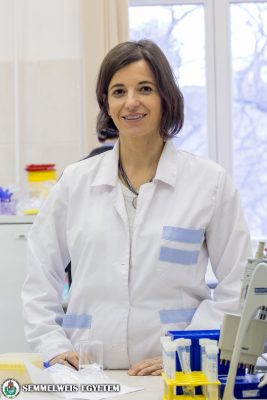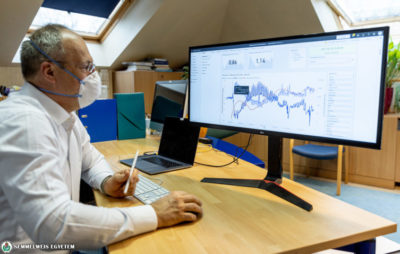 The Sigma-1 receptor is a relatively newly discovered molecule, and the fact that it plays a major role in the human body outside of the central nervous system as well was only discovered and has been researched in the past 4-5 years. Dr. Andrea Fekete, senior lecturer at the 1st Department of Pediatrics, along with her research group funded through the Hungarian Academy of Sciences’ (MTA) “Lendület” (Momentum) program, was first to publish their findings in 2016. Their results suggest that Sigma-1 plays a role in hypoxia kidney damage, and thus could be a suitable target in pharmaceutical developments in this area.
The Sigma-1 receptor is a relatively newly discovered molecule, and the fact that it plays a major role in the human body outside of the central nervous system as well was only discovered and has been researched in the past 4-5 years. Dr. Andrea Fekete, senior lecturer at the 1st Department of Pediatrics, along with her research group funded through the Hungarian Academy of Sciences’ (MTA) “Lendület” (Momentum) program, was first to publish their findings in 2016. Their results suggest that Sigma-1 plays a role in hypoxia kidney damage, and thus could be a suitable target in pharmaceutical developments in this area.
Next, together with her colleague Dr. Ádám Vannay they also wrote an article on how the Sigma-1 receptor may play a significant role in fibrosis, or fibrotic tissue scarring, and not only in the kidney but in the lung as well, meaning that it could be a good target for developing drugs for the treatment of pulmonary fibrosis. This discovery has been protected by a patent since 2019 in the US, and has been registered this year in China and several other countries. The patent is owned in 95% by the MTA and in 5% by Semmelweis University, and its exclusive use belongs to SigmaDrugs, a spinoff company associated with Semmelweis University, whose co-owner and director is Dr. Fekete.
Dr. Fekete pointed out that in their patent, they demonstrated the effects on the lung precisely through an example where there was pneumonia and fibrosis – which are the complications caused by COVID-19. That is why the researcher started studying the question of what role the activation of Sigma-1 might play in the treatment of illnesses caused by the coronavirus. The molecule’s quick anti-inflammatory effect is known, and based on literature researchers also raise the subject that the anti-malaria drug hydroxychloroquine sulfate acts through the Sigma-1 receptor. This reinforced their notion that the molecule may play a key role in future therapies for COVID-19.
There are drugs available on the market today that activate this receptor as a kind of “side effect” to their main therapeutic effect. For that reason, Dr. Fekete is currently compiling a research protocol that SigmaDrugs is planning to submit soon to the National Institute of Pharmacy and Nutrition (OGYÉI), so that the drug may be used in coronavirus patients through an expansion of its indication as soon as possible.
Dr. Fekete emphasized that in the current epidemiological situation, an even more intensive cooperation between the state, academic, university and private sectors can be seen both in Hungary and abroad, in order to find a treatment as soon as possible for COVID-19. The research group’s experiments are being funded, in addition to government and MTA grants, by the venture capital firms of major biotech investors Attila Várkonyi (FastVentures) and Csaba Lantos (Futurmed), which are cooperating with the university on several projects.
Dr. Fekete’s group conducts mostly studies in nephrology and diabetology. In recent years their attention has turned to the treatment of eye complications caused by diabetes, and they are also developing a storage liquid for transplantations that could extend the period of time that certain organs (such as the cornea) can be used for transplantation.
Pálma Dobozi
Translation: Tamás Deme
Photo: Attila Kovács – Semmelweis University (archive photos)


